What Is Real-World Asset Tokenization and Which RWA Projects Should You Invest in?
2025-01-16 10:29:35Key Points:
The integration of real-world returns into DeFi is seen as a viable solution to the low yields from traditional avenues, with RWA tokenization offering a way to bridge the gap between on-chain and off-chain assets.
The tokenization of RWA is considered transformative for the investment landscape, providing benefits such as fractional ownership, lower investment minimums, and increased market liquidity.
The RWA sector is gaining prominence with significant market capitalization growth and the introduction of innovative projects and funds, such as BlackRock's BUIDL tokenized fund.
Introduction
Last year in 2023, amidst a climate of risk aversion, institutions found the mid-single digit returns from DeFi yields too meager for the associated risks. Integrating real-world returns into DeFi presents a viable solution when traditional avenues fall short on-chain. Following a surge in meme speculation, the concept of Real-World Assets (RWA) gained traction. As of March 26, 2024, according to CoinGecko, the RWA sector is widely recognized with a total $7,432,081,247 market cap. Leading the way, Ondo Finance's native token ONDO saw an increase of over 110% in a week, positioning it at the forefront of RWA protocols, with several other RWA project tokens reaching new peaks.
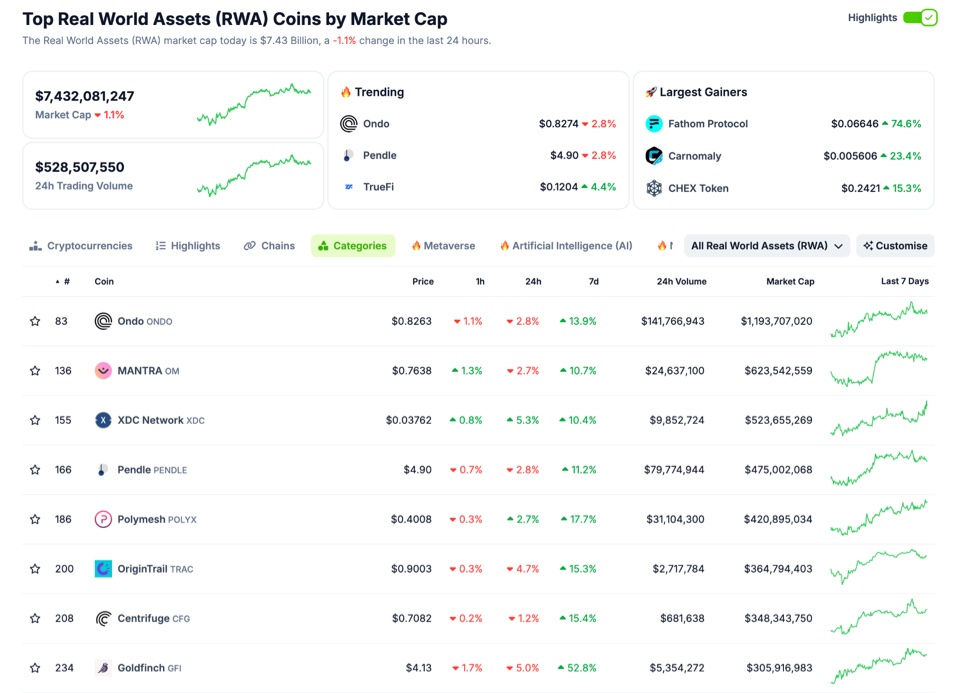
All RWA category, Source:CoinGecko
On March 21st, 2024, BlackRock launched BUIDL, a groundbreaking tokenized fund designed to offer qualified investors the opportunity to generate income denominated in U.S. dollars. This fund, also known as the USD Institutional Digital Liquidity Fund, commits 100 percent of its assets to cash, U.S. Treasuries, and repurchase agreements. Leveraging blockchain technology, it rewards investors with daily accrued dividends paid as new tokens directly into their digital wallets. In recent news, BUIDL has grown to $381.76 million, surpassing Franklin Templeton's BENJI to become the largest Real World Asset (RWA) tokenized offering. Previously, Franklin Templeton held the lead in this niche with a market cap of $368.07 million but has now fallen to second place.
Following the fund's launch, the ONDO price experienced a significant surge, doubling its weekly gains. Despite this bullish market sentiment, the DeFi sector remains relatively unaffected. Data from DeFi Llama indicates that the median DeFi yield has marginally increased from a low of 2% between early 2022 and July 2023 to currently stand at 3.24%. However, this is still modest compared to the 4.22% yield of the 10-year U.S. Treasury. In response, integrating real-world earnings into DeFi has emerged as a promising solution to enhance on-chain revenue generation.
What Is Tokenizing Real-World Assets (RWA)?
Blockchain technology is increasingly reshaping the traditional financial market, with tokenization emerging as the foremost opportunity to overhaul outdated systems. Essentially, tokenization involves transferring real-world assets (RWAs), both tangible and intangible, onto the blockchain. The influence of tokenization on financial markets extends beyond simply placing "things on the chain," offering profound implications for the industry.
RWA tokenization involves transforming tangible assets like real estate, precious metals, art, and collectibles into digital tokens on a blockchain. This process allows assets traditionally represented by physical deeds or certificates—like a house's ownership deed—to be managed and transacted digitally. Tokenization enables these assets to be traded directly between parties or even fractionally to a broader audience.
RWA tokenization isn't limited to high-value items like vintage cars or gold; it also extends to financial instruments such as U.S. Treasuries, currencies, and stocks. Unlike traditional markets, which can take up to 72 hours to settle transactions, blockchain transactions can settle almost instantly. This accessibility benefits smaller investors, enabling them to participate in markets previously beyond their financial reach. In the realm of fiat currency, stablecoins exemplify RWA tokenization. Tokens like Tether or USDC are backed by actual dollars, with each token representing a dollar held in reserve, facilitating faster and more direct settlements between parties.
Why Should Real World Assets Be Tokenized?
Tokenizing RWA offers transformative advantages for the investment landscape. By converting physical assets into digital tokens, the process streamlines the management of assets with enhanced efficiency, slashing the time and costs traditionally linked with their transfer. This digital transformation opens up investment opportunities to a broader audience through fractional ownership, reducing the minimum investment thresholds and thus democratizing access to previously exclusive markets.
Benefits of the RWA Assets
The benefits of transferring ownership of real-world items to a blockchain are substantial:
Efficiency: Tokenization can make the transfer of assets more efficient by reducing the time and cost associated with handling physical assets.
Accessibility: Tokenization can make RWA more accessible to a wider range of investors, as it allows for fractional ownership and lower investment minimums.
Liquidity: Tokenization can increase the liquidity of RWA by enabling faster and more efficient trading on secondary markets.
Transparency: Tokenization can provide greater transparency and security in the ownership and transfer of assets, as it allows for the use of blockchain technology to create an immutable record of ownership.
Compliance: Tokenization can help ensure compliance with regulations by providing a clear and transparent record of ownership and transfer of assets.
Furthermore, the liquidity of these assets significantly improves, facilitating quicker and more streamlined trades in secondary markets. Leveraging blockchain technology, tokenization also heightens transparency and security, creating an immutable and clear record of asset ownership. This not only simplifies compliance with regulatory requirements but also fortifies trust in asset transactions. Overall, the move to tokenize RWA introduces a more accessible, efficient, and transparent system for trading and investing in tangible assets.
What Sets Real World Assets (RWA) and NFTs Apart?
RWA and NFTs are both blockchain-based technologies, but they serve different purposes and have distinct contexts. RWA is used to calculate capital requirements for banks by digitizing physical assets like real estate and mortgages as tokens on the blockchain. NFTs, on the other hand, are unique digital assets that represent ownership or proof of authenticity for various items like art, music, or collectibles. They are commonly associated with digital art and have gained popularity in the art world, allowing artists to monetize their digital creations.
Top and Popular RWA Projects to Invest in for 2024
The RWA sector has become a significant topic of interest in the finance and blockchain communities. With major corporations like BlackRock exploring RWAs and Tether launching a dedicated platform, the sector has seen remarkable growth, culminating in RWA tokens reaching a record market capitalization of $2.7 billion in February 2024. As 2024 progresses, the RWA narrative is poised to gain even more prominence. Here we are going to offer a comprehensive overview of RWA projects, detailing the various types of assets being tokenized and highlighting key projects that are leading the way:
Ondo Finance: Successfully Pivoted to Offering RWA Sector
Ondo Finance initially focused on liquidity services and then later transitioned into the RWA space. They introduced products like OUSG, USDY, and OMMF, which are linked to U.S. Treasury bonds, dollar interest rates, and U.S. government money market funds. Despite the project’s success in this new domain, evidenced by its high Total Value Locked (TVL) and thoughtful product design, there is still ambiguity surrounding the practical use case of its native ONDO token. While the token has seen a price increase post-unlocking and has potential uses in governance and possibly as an incentive for RWA products, its integration with Ondo's offerings and the allocation of the majority of tokens remain unclear.
The RWA sector has experienced a surge in token prices, with Ondo Finance's ONDO token doubling in value and other RWA tokens also posting substantial gains. Ondo Finance, a Web3 company that creates and manages financial products for institutions, has seen its token price rise to $0.93, marking a 24-hour increase of 29% and a weekly surge of over 110%. The company has secured $24 million in funding from notable investors and boasts team members with backgrounds in traditional finance and DeFi. The recent bullish sentiment in the RWA market is attributed to BayPark's introduction of the BUIDL fund, which offers tokenized access to dollar-denominated earnings for qualified investors. BayPark's collaboration with Securitize, a digital asset securities company with SEC registration and significant funding, underscores the financial giant's positive view of the RWA sector, following its successful Bitcoin ETF. This move by BayPark is seen as a significant endorsement of the RWA space within the cryptocurrency industry.
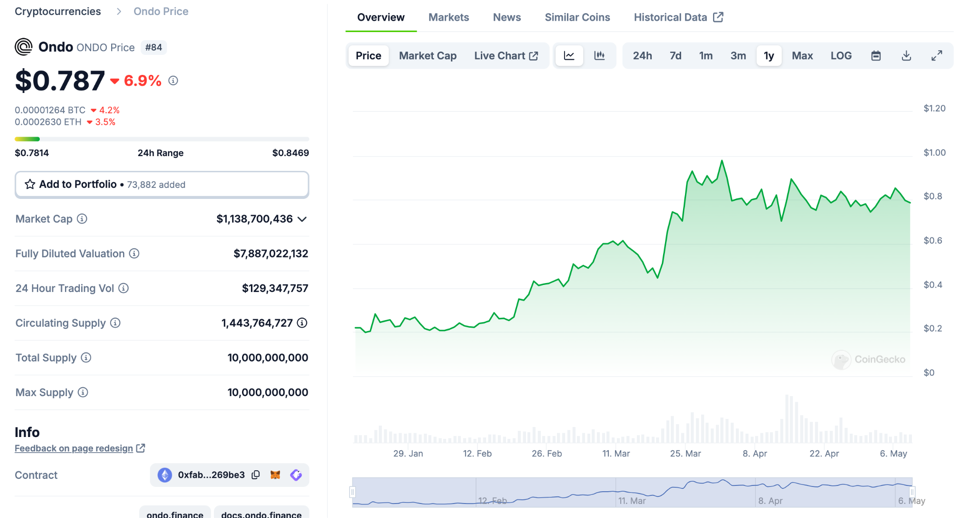
A year chart for ONDO, Source: CoinGecko
MANTRA: Tokenize, Trade, Trust in RWA Innovation on a Compliant Chain
MANTRA Chain is an L1 blockchain developed using the Cosmos SDK. It is designed as a network for businesses to collaborate, attracting companies and developers to create anything from NFTs and games to meta-cosmos and compliant DEXs. The first DApp on the MANTRA Chain is MANTRA Finance, which aims to be a globally regulated DeFi platform. This platform seeks to merge the speed and transparency of DeFi with traditional finance (TradFi), enabling users to issue and trade real-world asset (RWA) tokens.
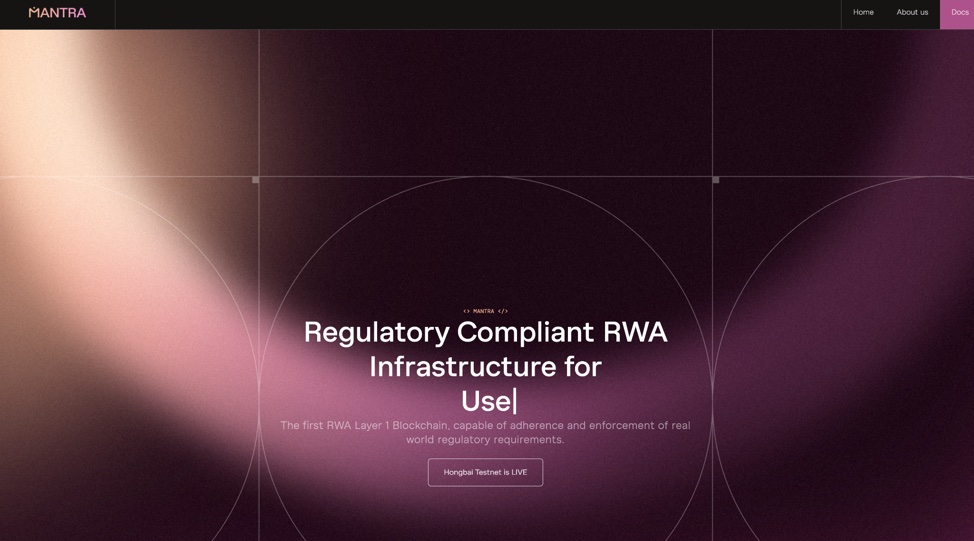
Source: MANTRA website
On March 19th, MANTRA announced the completion of an $11 million funding round led by Shorooq Partners, with participation from Three Point Capital, Forte Securities, Caladan, Virtuzone, Hex Trust, Token Bay Capital, GameFi Ventures, Mapleblock, Fuse Capital, 280 Capital, and others. The new funding will be used to help MANTRA achieve three key goals: building a compliant infrastructure, providing support for developers, and expanding the scope of the RWA tokenization program.
At the time of writing, the market capitalization of MANTRA (OM) is $591,130,636 with a circulating supply of 820 million OM tokens. In the past 24 hours, the trading volume of OM is $16,538,659. The yearly gain of MANTRA (OM) in 2024 is 2429.6%. This means that the OM price has increased by 2429.6% in the last year.
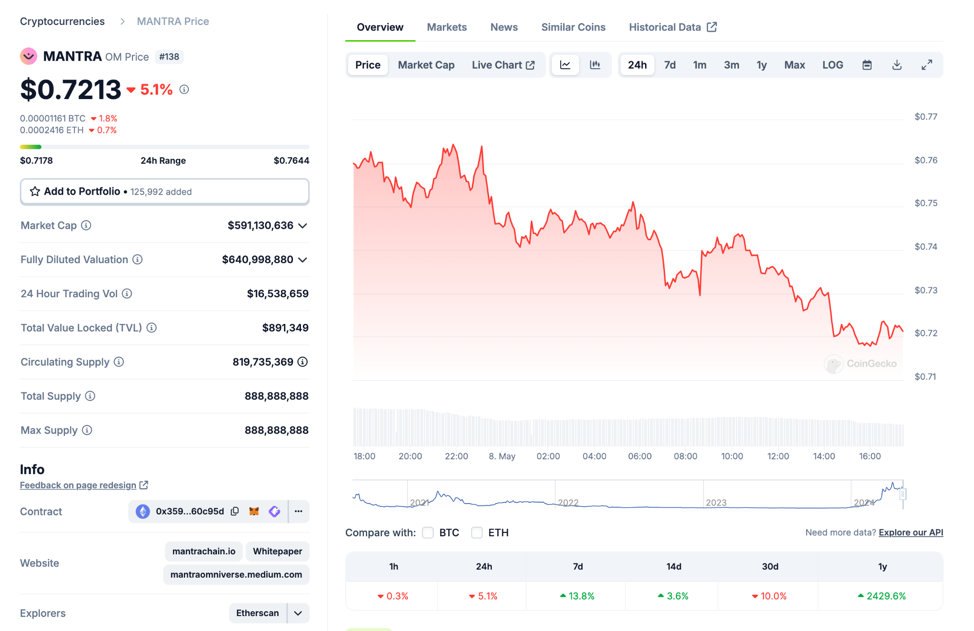
MANTRA market price & data, Source: CoinGecko
Polymesh: Real-World Assets on the Forefront of Blockchain Innovation
Polymesh is an institutional-grade, permissioned blockchain designed specifically for RWA tokens. It integrates governance, identity, compliance, and confidentiality directly into the blockchain's core. All participants, including token issuers, investors, and node operators, are required to undergo verification through decentralized KYC procedures.
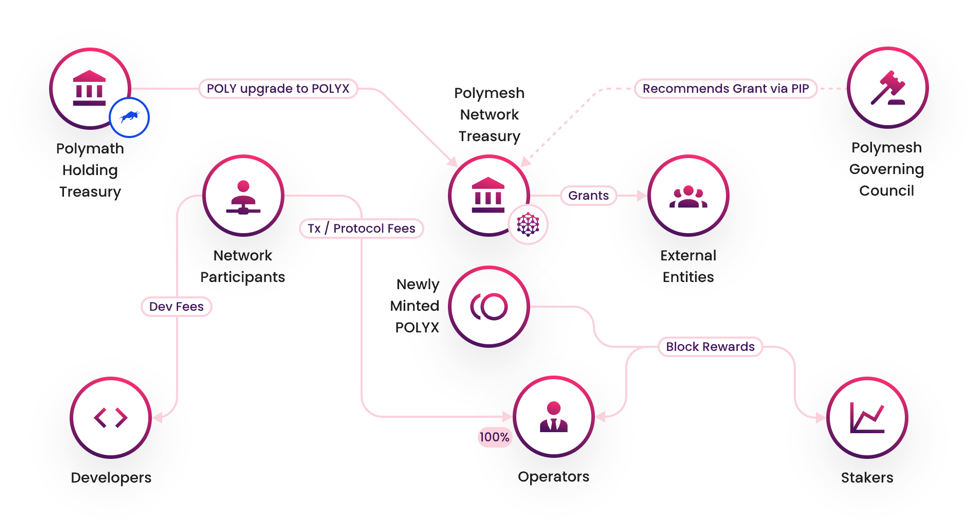
POLYX flow, Source: Polymesh website
Polymesh is a specialized layer 1 blockchain tailored for the security token market, offering a blend of transparency and trust through its public permissioned network. It requires identity verification for all participants, including node operators who must be licensed financial entities. The blockchain operates on a Nominated Proof-of-Stake (NPoS) consensus model, incentivizing good behavior and penalizing malicious actions through the POLYX token. Polymesh's unique features include its focus on security tokens, forkless architecture, and compliance with real-world regulatory requirements.
POLYX is integral to the ecosystem, serving as the medium for governance participation, staking activities, and the creation and management of security tokens. The Polymesh ecosystem is supported by initiatives like the Grants Program and the Ecosystem Development Fund, fostering growth and innovation within the platform. The Polymesh native token, POLYX, is classified as a utility token under Swiss law. Polymesh has shown significant growth since its all-time low in September 2023, with the current price being nearly 287% higher.
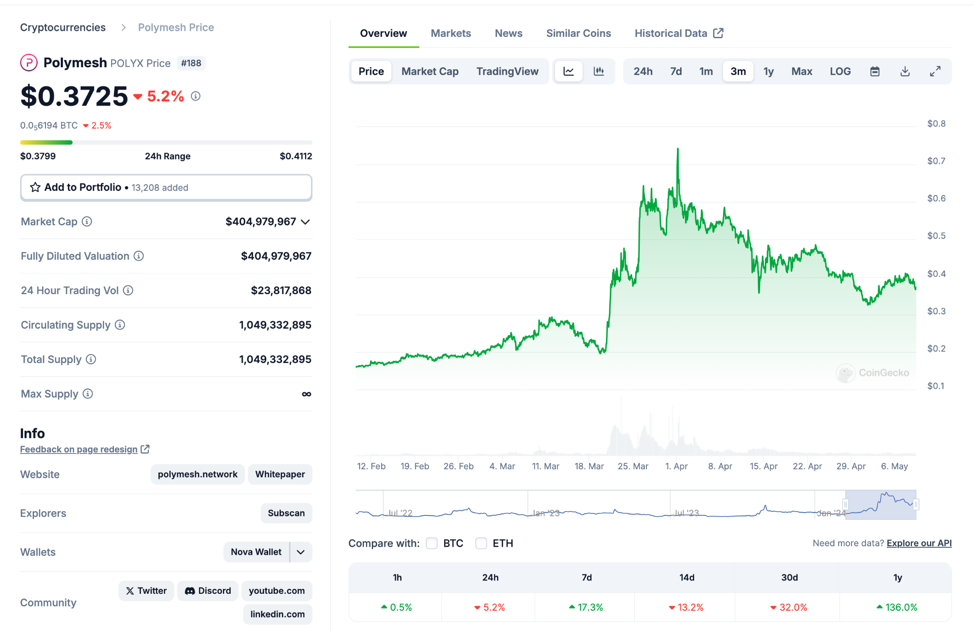
POLYX market price & data, Source: CoinGecko
What Are the Key Challenges Facing RWA Tokenization?
RWA tokenization presents an innovative frontier for blockchain technology, promising to revolutionize how we manage and transfer asset ownership. This process involves converting rights to a physical asset into a digital token, potentially offering more efficient transactions and broader accessibility through fractional ownership. However, despite its potential, the path to widespread adoption of RWA tokenization is fraught with significant challenges.
1. Establishing Token Legitimacy
The ease of creating NFTs on blockchain platforms belies the complex challenge of proving their worth. Unlike digital art NFTs, which derive value from market demand (e.g., Bored Ape Yacht Club collectibles), RWA tokens must represent tangible assets whose ownership is traditionally verified through established legal frameworks. Ensuring that an NFT accurately represents ownership of a physical asset requires robust mechanisms to prevent the proliferation of fraudulent tokens, which could undermine trust in this nascent market.
2. Legal Acceptance and Enforceability
For RWA tokenization to function effectively, it must gain recognition not only in the marketplace but also in the legal system. Traditional assets are often subject to legal disputes or requirements that necessitate authoritative intervention, such as a court-ordered transfer of ownership. The decentralized nature of blockchains makes it challenging to enforce such legal actions without built-in mechanisms or the potential risk of compromising security and privacy by granting legal authorities access to private keys.
3. Security of Token Contracts
The security of the smart contracts on which tokens are based is paramount. Vulnerabilities in the contract code can lead to hacks, resulting in the loss or unauthorized transfer of assets. In the case of RWA tokenization, a breach could lead to disputes about the physical asset's ownership, requiring complex resolutions that question the integrity of the tokenization process. Ensuring the reliability and security of smart contracts is crucial to protecting asset ownership and building trust in RWA tokens as legitimate and stable representations of real-world assets.
While RWA tokenization holds immense promise for transforming asset management and ownership, addressing these challenges is crucial for its success. Innovations in legal frameworks, security protocols, and token authenticity verification are essential to overcoming these barriers and realizing the full potential of this technology. As developers and regulators work together to forge this new path, the future of RWA tokenization remains an exciting prospect filled with both opportunities and obstacles.
What Are the Next Steps for Tokenizing Real-World Assets?
The Real World Assets (RWA) sector is one of the fastest-growing areas in cryptocurrency. Many view them as a way to capitalize on trillions of dollars in global assets and drive growth across the industry. Larry Fink, CEO of BlackRock, has described RWAs as 'the next generation of the marketplace.' The Boston Consulting Group predicts that by 2030, converting these assets into tokens could unlock a $16 trillion opportunity.
To date, however, the only asset that has been successfully tokenized and fully integrated into the crypto ecosystem is fiat currencies, in the form of stablecoins. Stablecoins represent the first, largest, and most mature RWAs. They have carved out a market in products suitable for cryptocurrency use and continue to see strong demand across various services, making them a fundamental part of every cryptocurrency ecosystem.
As we look towards the future of tokenizing RWA, several crucial developments are set to pave the way for this innovative financial landscape. First and foremost, regulatory clarity is needed. Clear regulations must be established to ensure compliance with existing financial laws and to support the legal issuance and trading of these tokenized assets. This will provide a strong foundation for the market’s growth.
Alongside regulatory developments, technological advancements are essential. Blockchain infrastructure must continue to evolve to meet the demands of scalability, security, and interoperability required for the widespread adoption of tokenized assets. This technological progression will enable the seamless integration of these assets into traditional financial markets, allowing for an efficient exchange between tokenized and traditional assets.
Moreover, there is a pressing need for standardization across the industry. Creating uniform standards for the issuance, reporting, and trading of tokenized assets will enhance transparency and build investor confidence. Educating potential investors and market participants about the benefits and risks associated with these assets is also vital. This will cultivate a well-informed marketplace, ready to engage with new financial products and services that leverage tokenized assets, including decentralized finance (DeFi) applications.
The scope of tokenization needs to expand beyond traditional financial instruments. There is significant potential in diversifying into other assets such as real estate, art, and collectibles. This expansion will open up new investment opportunities and liquidity options, broadening the horizon for what tokenized assets can achieve. These steps are not only vital for the maturation of the RWA tokenization market but are also key to unlocking the predicted $16 trillion opportunity by 2030, as estimated by the Boston Consulting Group.
Conclusion
The tokenization of Real World Assets (RWA) marks a transformative advancement in the financial landscape, offering profound implications for asset management and investment accessibility. This innovative approach not only simplifies the transaction processes associated with tangible assets but also democratizes access to investment opportunities that were previously reserved for affluent or institutional investors. By leveraging blockchain technology, RWA tokenization enhances transparency, security, and efficiency, making it easier and more cost-effective to manage and trade assets on a global scale.
Ultimately, the successful expansion of the RWA sector could unlock trillions of dollars in global assets, significantly altering the investment landscape. By 2030, as predicted by industry leaders and analysts, the tokenization of real-world assets could transform the economic structures we rely on today, making them more inclusive, efficient, and adaptable to the changing needs of a global economy. This shift not only promises substantial economic benefits but also fosters a more equitable distribution of wealth and resources across societies, heralding a new era of financial innovation and inclusion.
FAQ
Q: What Is Tokenizing Real-World Assets (RWA)?
A: Tokenizing Real-World Assets involves converting tangible assets like real estate, precious metals, and other valuables into digital tokens on a blockchain. This process facilitates more efficient asset management and transactions, enabling direct or fractional trading among a broader audience.
Q: Why Should Real World Assets Be Tokenized?
A: Tokenizing Real World Assets streamlines the management and transfer of these assets, making them more accessible and cost-effective. It offers the benefits of fractional ownership, increased liquidity, and enhanced transparency through blockchain technology, making investments more democratic.
Q: What Sets Real World Assets (RWA) Apart From NFTs?
A: While both RWAs and NFTs utilize blockchain technology, RWAs represent tangible assets like property and gold, enabling investment and fractional ownership. NFTs, on the other hand, typically represent unique digital items or art, focusing on collecting and authenticity rather than traditional investment.
Q: What Are the Key Challenges Facing RWA Tokenization?
A: Key challenges include establishing token legitimacy, ensuring legal acceptance and enforceability, and maintaining the security of token contracts. Addressing these issues is crucial for the widespread adoption and trust in the tokenization of Real World Assets.
Disclaimer: The information provided in this article is intended only for educational and reference purposes and should not be considered investment advice. For more information, please refer to here. Conduct your own research and seek advice from a professional financial advisor before making any investment decisions. FameEX is not liable for any direct or indirect losses incurred from the use of or reliance on the information in this article.